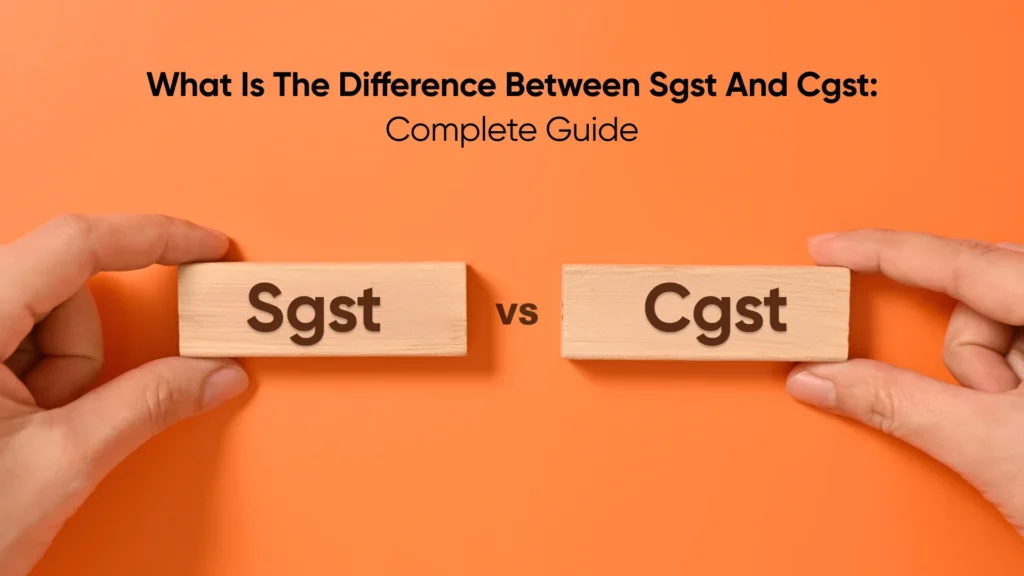What Is The Difference Between SGST And CGST: Complete Guide

Navigating the world of taxes can often feel confusing, especially when it comes to understanding the different components of the Goods and Services Tax (GST) system. Among the most important aspects of GST are SGST (State Goods and Services Tax) and CGST (Central Goods and Services Tax), two taxes that play a critical role in how businesses operate within India. But how do they differ, and why should every business owner and taxpayer understand them?
Whether you are a new entrepreneur or an established business, getting these details right can help streamline your financial operations and ensure compliance with the law.
Table of Contents
ToggleWhat is GST?
The full form of GST that stands for Goods and Services TAX. GST was introduced by the central government to clear all the indirect taxes like central excise duty, VAT, services tax, CESS, etc. This benefits all stakeholders as the consumers can enjoy lower prices, while businesses benefit from a single, consistent tax system across the country. It also makes it easier for manufacturers to buy raw materials and set up their operations. Plus, both central and state governments can collect taxes more efficiently and at a lower cost.
What is CGST (Central Goods and Services Tax)?
The full form of CGST that stands for Central Goods and Services Tax. This tax is imposed by the Central Government on the supply of goods and services within a state. This tax was put into effect to replace various taxes like central excise charge, service tax, and customs duty. This tax is collected by the Central Government and the revenue is used to finance various activities.
What is SGST (State Goods and Services Tax)?
The full form of CGST that stands for State Goods and Services Tax. SGST stands for State Goods and Services Tax. It is the tax levied by the state government on intrastate supplies of goods and services. SGST tax was introduced to take the place of value-added tax, entertainment tax, luxury tax, entry tax, etc. The State Government has autonomy to spend this tax collected on various developmental activities.
Key Differences Between CGST and SGST
While both apply to the same transaction, CGST and SGST have different roles. Let’s understand the key differences:
Aspect | CGST (Central GST) | SGST (State GST) |
Full Form | Central Goods and Services Tax | State Goods and Services Tax |
Levied By | Central Government | State Government |
Revenue Sharing | The Central Government may share the revenue collected from CGST with State Governments, as needed. | The State Governments do not share the revenue collected from SGST with the Central Government. |
Purpose | The revenue collected goes to the central government | The revenue collected goes to the state government |
Input Tax Credit | Can be used against CGST and IGST liabilities | Can be used against SGST and IGST liabilities |
Taxes incorporated | The tax incorporated within CGST includes central surcharges, CESS, central excise duty, other central indirect taxes | The taxes incorporated in SGST includes Value Added Tax (VAT), state surcharge & CESS, other state taxes |
How CGST and SGST Work Together in Intra-State Transactions
Whenever goods or services are sold within the same state, two types of taxes are applied:
- CGST (Central GST) that goes to the Central Government
- SGST (State GST) that goes to the State Government
CGST and SGST are charged at the same rate.
So if GST is 18%, it’s split as:
- 9% CGST
- 9% SGST
For instance: If you sell something worth ₹10,000, the total GST will be:
- ₹900 as CGST
- ₹900 as SGST
Total GST = ₹1,800
This total GST is collected together from the customer but shared separately between the Centre and the State. Paying the correct CGST and SGST ensures you are following the rules and avoiding fines. This also helps simplify and streamline the GST return filing process.
Also Read: Penalty For Late Filing of ITR: Everything You Need to Know
Examples Illustrating CGST and SGST Application
Situation 1: A person in Pune (Maharashtra) buys furniture worth ₹10,000 from a local store in Pune. Since both buyer and seller are in the same state, this is an intra-state transaction.
GST rate is 18%, which is split as:
- 9% CGST = ₹900 → Goes to the Central Government
- 9% SGST = ₹900 → Goes to the Maharashtra State Government
Total Amount Paid by Customer = ₹10,000 + ₹900 + ₹900 = ₹11,800
Situation 2: A person in Delhi orders the same furniture online from a seller based in Mumbai (Maharashtra). Since the seller and buyer are in different states, this is an inter-state transaction.
GST rate is again 18%, but here it’s charged as IGST:
18% IGST = ₹1,800 → Entire amount goes to the Central Government, who later share a part with the buyer’s state.
Total Amount Paid by Customer = ₹10,000 + ₹1,800 = ₹11,800
Impact of CGST and SGST on Businesses
The impact of CGST (Central Goods and Services Tax) and SGST (State Goods and Services Tax) on businesses is significant, as these taxes directly affect pricing, cash flow, and compliance processes.
1.Pricing Impact: As CGST and SGST are levied on intra-state transactions, businesses need to factor in these taxes when setting the price of their goods or services. This may increase the final price of products/services.
2.Input Tax Credit (ITC): Businesses can claim input tax credit (ITC) on CGST and SGST paid for raw materials or services used in their operations. This helps lower their overall tax cost by reducing the amount they need to pay.
3.Compliance and Documentation: Businesses need to maintain accurate records of CGST and SGST paid on purchases and collected on sales. Businesses also need to be registered under GST and get a GSTIN number. They now need to file regular returns to report their tax and may have invested in technology and staff to stay compliant. This has resulted in higher compliance costs, especially for small and medium-sized businesses.
4.Cash Flow: GST payments need to be made regularly, which could affect a business’s cash flow. The split between CGST and SGST means businesses need to manage payments to both the central and state governments separately.
5.Impact on Interstate Sales: For interstate transactions, businesses will need to manage IGST instead of CGST and SGST, and they need to handle these taxes differently. This ensures proper tax credit and filing for both types of transactions.
6.Market Competitiveness: Introducing CGST and SGST ensures uniform tax structure across the country. This reduces tax complexity while fostering better competition in both state and national markets.
7.Increased Transparency: Businesses now have more visibility and traceability in their tax payments, as CGST and SGST are clearly separated, promoting tax compliance and reducing the chances of evasion.
While CGST and SGST impacts pricing, compliance, and cash flow of businesses, they also provide opportunities to reduce tax liability through input tax credits. This promotes a more efficient and transparent tax system.
Also Read: Impact of GST Rates on Personal Loans
How to File CGST and SGST Returns?
- Register on the GST Portal
- Visit www.gst.gov.in and log in with your GST credentials.
- Choose the Correct Return Form
- GSTR-1: Details of outward supplies (sales)
- GSTR-3B: Summary return for tax payment
- Others include GSTR-4 (for composition scheme), GSTR-9 (annual return), etc.
- Upload Invoices & Input Tax Credit (ITC): Report all sales and purchases to claim input tax credit under CGST and SGST.
- Verify and Submit: Review data and confirm correctness.
- Pay Tax Liability: Make payment for CGST, SGST, or IGST (if applicable) via online banking or a challan.
- File Returns: Submit the final return form electronically using a Digital Signature Certificate (DSC) or Electronic Verification Code (EVC).
Common Mistakes to Avoid When Dealing with CGST and SGST
- Late or Inaccurate GST Return: It is important to file the GST within the due date. Not filing GST return on time or failure to file return may lead to cancellation of GST registration and penalties. Another key aspect to remember is to input correct details to ensure a successful input tax credit process.
- Not Filing a NIL Return: As a business, it is imperative to file a GST return. Even if your business does not make any money or there are no transactions, you must still file a NIL return.
- Not Maintaining Separate Records for CGST and SGST: Keeping combined records for CGST and SGST can cause confusion when filing returns. Ensure that separate records are maintained for both taxes, making it easier to claim input tax credits and file returns accurately.
- Incorrect GSTIN Registration Ensure your business is correctly registered under CGST and SGST and has the proper GSTIN (Goods and Services Tax Identification Number). Failure to do so can lead to issues with tax compliance and difficulty in claiming ITC.
- Not Understanding State-Specific Rules: While CGST is uniform across the country, SGST rules can vary slightly depending on the state. Not understanding state-specific rules can result in mistakes in the filing process.
Conclusion
Whether you’re a business owner managing your tax obligations or a consumer curious about the tax structure, knowing how these taxes work can help you make informed financial decisions. So, next time you encounter these taxes, you will understand not just who is collecting them, but why they matter to the economy and how they impact your wallet!
Frequently Asked Questions
What Are The Main Differences Between CGST And SGST?
The main difference between CGST and SGST is that CGST is imposed by the Central Government and SGST is imposed by the State Government.
Can CGST And SGST Rates Differ For The Same Product?
No, CGST and SGST rates are the same for the same product.
Who Is Responsible For Collecting CGST And SGST?
The central government collects the CGST, and the state government collects the SCST.
How Are CGST And SGST Applied In Intra-State Transactions?
In intra-state transactions, GST is split equally into CGST and SGST, where CGST goes to the Central Government and SGST to the respective State Government. Both are applied at equal rates for the same transaction.
Are There Any Exemptions Under CGST And SGST?
Yes, under CGST and SGST in India, exemptions are available for certain goods and services like unprocessed food items, healthcare, and educational services. The aim is to reduce the tax burden on essential commodities.
How Do I File Returns For CGST And SGST?
To file CGST and SGST returns in India, visit the GST portal and submit the required return forms like GSTR-1 and GSTR-3B, based on your registration type and turnover. Returns must be filed monthly or quarterly as per GST rules.
What Happens If I Fail To Comply With CGST And SGST Regulations?
Failure to comply with CGST and SGST regulations can lead to penalties, fines, or interest charges, and may result in the suspension or cancellation of GST registration. It depends on the severity of the non-compliance.
How Do CGST and SGST Impact Pricing Strategies For Businesses?
CGST and SGST impact pricing strategies by adding a tax component to the product price, which businesses must factor in to maintain profit margins while remaining competitive. Businesses may adjust pricing to absorb or pass on the tax burden to customers.
Can Input Tax Credit Be Claimed For Both CGST and SGST?
Yes, Input Tax Credit (ITC) can be claimed for both CGST and SGST, provided the taxes were paid on eligible business expenses, and the goods or services are used for business purposes. The credit for CGST can only be used against CGST liabilities, and similarly, SGST can only be used against SGST liabilities.
Where Can I Find The Latest Updates On CGST and SGST rates?
You can find the latest updates on CGST and SGST rates on the official GST Portal and the CBIC (Central Board of Indirect Taxes and Customs) website, which regularly publishes notifications and rate revisions.
YOU MAY ALSO LIKE


Search by posts
Recent post
Categories
- Blog (6)
- Credit History (37)
- Credit Line (7)
- Festive (4)
- Finance (15)
- Mutual Fund (19)
- Personal Loan (297)
- Tax (8)
- Zype (4)












